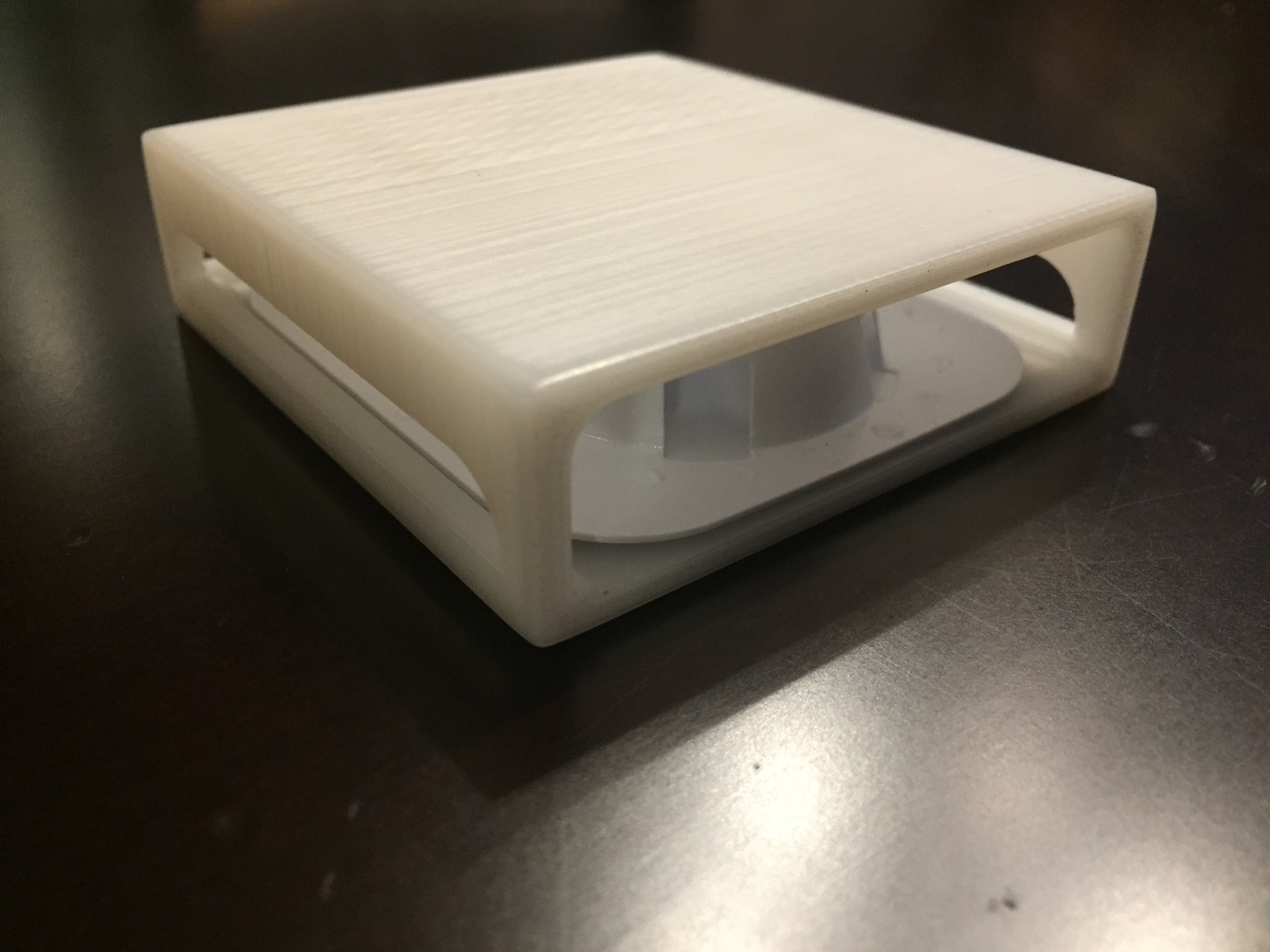
Abstract
Cockroaches and ants are among the most common home pest infestations. Whether a homeowner has ants in the kitchen or cockroaches in the bathroom, everyone is susceptible. Ants and roaches can be hard to get rid of because of their sheer numbers and strong survival tactics. There are numerous methods on the market, including foggers, sprays, and bait stations. All offer ant and roach remediation at differing degrees of safety for those in the household. Children and pets are most at risk for both acute and chronic health issues. Acute poisoning occurs shortly after a single exposure, while chronic poisoning occurs gradually upon repeated exposure. This paper will demonstrate how a simple universal bait station holder can greatly reduce the risk of unintentional poisoning of children and pets.
How Pesticides Work
Pesticides can enter the body in three ways:
- Oral – by directly ingesting the toxin or by inadvertently transferring it to the mouth from the hands.
- Respiration – inhaling sprays, vapors or powders through the nose or mouth.
- Dermal – Absorbing pesticide spray through the skin or eyes.
Pesticides in the Home
Pesticides are generally defined as any substance or mixture of substances intended for preventing, destroying, repelling or mitigating any pest. (Rose, Hodgeson & Roe, 1999) Modern pesticides are very effective at ridding unwanted pests, and their use in homes is on the rise. During 2017, 75% of U.S. households applied a minimum of one product containing pesticides indoors. (U.S. EPA, 2017)
Sold in forms such as sprays, liquids, sticks, powders, crystals, balls, and foggers, these products work differently. They are toxic to differing degrees and pose differing short and long-term risks. Many pesticides also contain inert ingredients that are added to the insecticide to help carry the active ingredient, and some of these inert ingredients can cause health problems as well. (U.S. EPA, 2017) While bait stations are considered lower in toxicity than airborne pesticides, each year, doctors, hospitals, and veterinarians are confronted with children and pets who have found and ingested some of the poison within and/or the plastic bait stations themselves.
Household pesticides are widely available at supermarkets or hardware stores and are designed for homeowners to administer themselves. Their ease of availability over the counter does not infer that they are harmless.
Spray and Aerosol Insecticides
These types of pesticides create a fine aerosol mist that moves through all the air in the treated area, killing their targets on contact. They provide an effective short-term pest control solution in that they eliminate the pests you can see but they do not solve for the larger problem of eliminating pests you cannot see – those in the nest or colony.
Spray and aerosol use greatly impact indoor air quality. 80% of most people’s exposure to pesticides occurs indoors with measurable levels of up to one dozen pesticides found in the air inside homes. (U.S. EPA, 2017) A homeowner’s air conditioner or central heating can keep airborne pesticides in circulation. In addition to inhaling the toxins in the air, they settle on countertops and furniture, where residents, including children and pets, unknowingly come into direct contact.
Bait Stations
Ant and roach bait stations are small plastic cups that attract pests with food and liquid mixed with a low-level insecticide. Ant and roach bait stations on the market today contain common pesticides such as boric acid, avermectin, fipronil, hydramethylnon, propoxur, and sulfluramid. (Pesticide Research Institute, 2017)
The target eats the pesticide, which is slow-acting. In the time between when they ingest the poison and their death, the ants and roaches have enough time to carry some insecticide back to the main colony or nest where they spread it among the rest of the colony.
Since roaches and ants have nests in hard-to-reach areas and even out of doors where sprays and aerosols have little or no access, bait stations are the more effective short-term and long-term pest control solution. Because the roaches and ants infect others at the source, the ants and roaches in the colony receive a lethal dose of the active ingredient before the pests that ingested the toxins start showing signs of toxicity.
Children, Pets, and Pesticides
Poison.org lists pesticides in their list of top ten most common substances implicated in poison exposure – with just over 34,000 cases reported in 2017. (Poison Control National Capital Poison Center, 2017)
Children are especially susceptible to harm from the insecticides contained in home pest-control products because their bodies and immune systems are still developing (WebMD). These young children have not developed the life experience to know these bait stations are bad for them. Children in the one-year age group are at the greatest risk of ingesting poison because they are at a developmental stage where they are crawling on the floor and exploring their environment by putting things in their mouths. Young children and pets can discover bait stations even when tucked away underneath or behind furniture. Parents who believe they are using the bait stations responsibly and correctly can be surprised at how their child or pet found what they believed was a safe and secure placement. A bait station cover can add an extra layer of security and peace of mind for dedicated parents. (WebMD)
Children are more vulnerable than adults are to the health risks of bait stations due to the higher rate of chemical intake measured by body weight. The toxins associated with ingestion also stay in their systems longer because the toxins are not processed through their systems as quickly. Parts of the body designed to help rid waste and toxins, such as the kidneys and liver, do not function the same in children as in adults and the process is much slower. (Liebman, A., Galvan, A., & Juarez, P., 2006).
In addition to symptoms caused upon ingestion such as dizziness, vomiting, diarrhea, weakness, and burns around the nose or mouth, children exposed to pesticides early in life have risk for long-term cognitive, neurologic, respiratory, and developmental problems.
Children do not process toxins as quickly as adults do – so more toxins stay in their systems longer. The parts of the human body such as the kidneys and liver that help get rid of waste or poison do not function like those of adults. An adult is more likely to be able to excrete or get rid of waste or poison than a child is. (Liebman, A., Galvan, A., & Juarez, P., 2006)
Children exposed to pesticides early in life are at risk for long-term cognitive, neurological, respiratory, and developmental problems. Exposure to indoor residential pesticides in early childhood is associated with an increased risk of developing childhood leukemia and lymphoma.
Children’s organs and internal systems grow and change rapidly. When they are exposed to chemicals during critical stages, it may disrupt their development and lead to long-term health and neurodevelopmental problems. (Alkon, A. PhD., Nouredini, S., PhD., Swartz, A., PhD., Sutherland, M., PhD., Stephens, M. Davidson, N., Rose, R., 2016)
These risks may be greater in low-income urban neighborhoods, where substandard housing conditions and resident behaviors increase the chances of pest infestation and pesticide usage, and in places such as schools and day care centers where ongoing pest management is imperative. (Ashley, P., Berko, J., Gaitens, J, Anderson, J., et al, 2011).
Pets are also vulnerable to the toxins in roach and ant bait stations, although they are not nearly as toxic to pets as they are to roaches and ants. A toxicology brief from Veterinary Medicine lists ants and roach baits in their “The 10 Most Common Toxicoses in Dogs,” writing that most ant and roach baits, along with insecticide, use peanut butter as an attractant (Meadows, I., Gwaltney-Brant, S., 2006), which is a flavor most dogs find appealing and often a flavor of pet treats. The toxicity level in ant and roach bait stations isn’t significant enough to seriously harm your pet. The more serious issue for pets is the ingestion of the plastic housing that holds the insecticide. The plastic can cause an obstruction or tear their intestinal tract or esophagus.
The Solution
Eliminating pests in the home should not require that children or pets be put in harm’s way.
Because of their lower toxicity and effectiveness at eliminating the targeted pests, the development of a solution whereby children and pets cannot ingest bait stations is a common sense solution to this serious problem.
To reduce the risk of acute and chronic health problems caused by the use of pesticides, TrapJak USA recommends the use of an Ant and Roach Bait Station Cover to augment ant and roach bait stations. This device covers and conceals bait stations to keep them out of the hands and mouths of children and pets. In addition, the bait station covers have an ergonomic design that blends in with any home or office, leaving them invisible to guests.
With a TrapJak Ant and Roach Bait Station Cover in place, bait stations will become the go-to product for household ant and roach extermination.
References
Rose, R., Hodgeson, E. & Roe, R. (1999) Toxicology, Science Direct
United States Environmental Protection Agency (2017) Retrieved on February 13, 2019 from https://www.epa.gov/indoor-air-quality-iaq/pesticides-impact-indoor-air-quality
Poison Control National Capital Poison Center (2017) Poison statistics: National data 2017, Retrieved on February 13, 2019 from https://www.poison.org/poison-statistics-national
Pesticide Research Institute (2017) Cockroach control, Retrieved on February 13, 2019 from https://www.pesticideresearch.com/site/pri-resource-centers/pest-mgmt/pest-mgmt-bulletins/cockroach-control
WebMD, Safer pest control, Retrieved on February 14, 2019 from https://www.webmd.com/children/pest-control#1
Liebman, A., Galvan, A., & Juarez, P, (2006) A little bit of poison…will it kill you?, Migrant Clinician, p. 21 – 23, Retrieved on February 13, 2019 from https://www.migrantclinician.org/files/resourcebox/poison_manual_eng.pdf
Alkon, A. PhD., Nouredini, S., PhD., Swartz, A., PhD., Sutherland, M., PhD., Stephens, M. Davidson, N., Rose, R. (2016) Integrated pest management intervention in child care centers improves knowledge, pest control, and practices, _Journal of Pediatric Health Care,_Vol 30, Issue 6. Retrieved on February 14, 2019 from https://www.sciencedirect.com/science/article/pii/S0891524516301596#bib20
Ashley, P., Berko, J., Gaitens, J, Anderson, J., Nishioka, M., Wooton, M., Zewatsky, J., (2011) Pesticides in the hone: Use, hazards, and integrated pest management, Healthy Housing Solutions, Retrieved on February 13, 2019 from http://healthyhousingsolutions.com/wp-content/uploads/2014/12/HUD_Pesticides-IPM_Paper_11-16-12.pdf
Meadows, I., Gwaltney-Brant, S. (2006), The 10 most common toxicoses in dogs, Toxology Brief, Retrieved on February 14, 2019 from https://www.aspcapro.org/sites/default/files/zm-vetm0306_142-148.pdf



